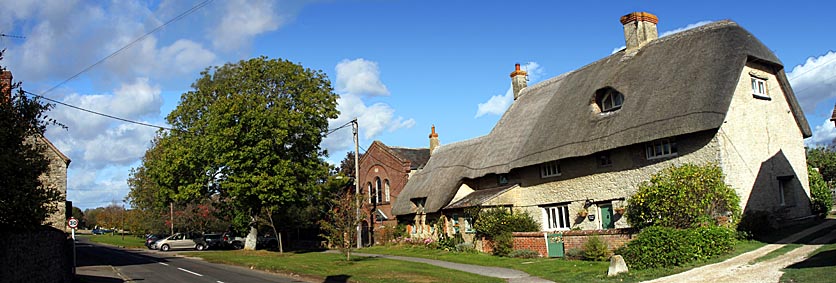 |
 |
|||
|
|
Stanford-in-the-Vale From Julianum to Inoculation
The
name means 'Stony Ford' and probably refers to a Roman Road travelling
over the River Ock, at Stanford Mill, to the Roman settlement at Wantage, though there is
no definite evidence of such. If it followed the line of the A417 it
would have missed Wantage, but the Roman town was on the western side
nearest this road. Local legend refers to a Roman
settlement at Stanford itself, called Julianum. However, only a single
Roman building has been found at Chinham Farm, in the west of the
parish, above Shellingford. Another name for this more upland area of
the parish was Chinnon Town which may just possibly be Indo-European
Kind-ion meaning 'Mountainous Place'. Stanford is associated with a legendary battle fought at Gainfield between the Saxons of King Aethelred the Unready and the Danes of King Canute in about 1015. At one point in the onslaught, the Danes pushed the Saxons all the way back to Stanford before finally overcoming them. During the reign of Aethelred's son, Edward the Confessor, the village was owned by a certain Siward. William the Conqueror then gave it, along with many other manors, to Henry de Ferrers. Compared with the other villages of the Vale of the White Horse, Stanford was quite substantial at the time of the Domesday Survey (1086). There were twenty-eight serfs & villeins (tenant farmers) and twenty-three bordars (cottage dwellers) and their families. There were two mills and a vast 318 acres of meadowland for the grazing of dairy cattle. This made Stanford the largest of the villages producing the milk and cheese for which the Vale was then famous. An irregular filled square moat surrounding Stanford Park Island, stands just east of Stanford Park Farm, north of Park Lane. It may originally have just been a series of fishponds which were later joined up to enclose a pleasure garden, presumably attached to the manor. King Henry III gave the Ferrers' descendant, the Earl of Derby, a gift of six bream to fill his fishponds at Stanford-in-the-Vale in 1231. The Earls lived chiefly at Tutbury Castle, and later also Chartley Castle, in Staffordshire, but they may have visited their manor at Stanford for the hunting in the Vale and on the Downs. They certainly undertook a lot of building work there in the 1230s, being granted 20 joists from Savernake Forest, 10 oaks for a new kitchen and then 30 more joists for an additional chamber. They also obtained, for the village, the right to hold a Thursday market and an annual fair on Church Green, where the stocks and pillory stood. The Earls lost the estate in 1307 and it became one of the many manors belonging to the Le Despencers and then the Earls of Warwick. Anne Neville, Warwick the Kingmaker's youngest daughter, is said to have stayed at the old manor house prior to her marriage to Richard III. To celebrate the Royal wedding, the villagers rebuilt the church porch featuring the Warwick arms. The rest of St. Denys' Church is of several periods stretching from the 12th to 14th centuries. It has a very interesting decorated stone pyx canopy or reliquary over its piscina. This is thought to have once held a finger bone of the building’s patron saint, lent to this little village by Abingdon Abbey. In the churchyard is an ancient gypsy gravestone over the remains of Gravelines Boswell. The Boswells were the largest and most important gypsy family in the country and Stanford was once a popular stop for them. The present manor house has 16th century fireplaces and its core was probably erected for Richard Knollys, MP for Wallingford, who was the fifth son of the Treasurer of the Royal Household, Sir Francis Knollys, who owned the manor. His own son, Sir Robert, seems to have largely rebuilt the place to what we see today early in the next century. He lived there until acquiring Greys Court in Oxfordshire from his uncle, the Earl of Banbury. There are a number of other notable residences in the parish, perhaps because of two important architectural families who lived in the village. Penstone's Farm is a partly 17th century house. It was the home of William Penstone, the architect of the local school (1872). It is now called Cromwell House since Oliver Cromwell is supposed to have spent the night there. However, the same story is told of King Charles I and this seems more likely as the Royalist army passed through Stanford on their march to Wantage and thence Newbury where they clashed with Roundheads at the 1st Battle there in 1643. About 1706, a Sheriff of Berkshire, Walter Tyrell, had the fine Rectory House built for him, north of the church where his wife has a handsome memorial. The Strong family of Stanford master masons, who carved many of the best gravestones in the churchyard, worked on the churches at Longcot and Uffington and probably built Cox's Hall (1739) for another Sheriff of Berkshire, Joseph Cox, about thirty years later. Joseph
Cox gave a flagon to the parish church in 1752. It has an interesting inscription: This
flagon is dedicated to the use of the altar, in the parish of Stanford in
the Vale for ever, This was some forty-four years before Edward Jenner first discovered the small-pox vaccine in 1796. However, Jenner himself noted, at an early age, the belief, among country folk, in the connection between small and cow pox, and there are known to have been earlier inoculators like Benjamin Jesty (1774) whose grave can be seen at Worth Matravers in Dorset. Presumably someone was doing similar early experiments in this area of Berkshire too.
|
|||
| © Nash Ford Publishing 2011. All Rights Reserved. This location is now administered by Oxfordshire County Council. | ||||



